Motorola Xoom Review: The First Honeycomb Tablet Arrives
by Anand Lal Shimpi on February 23, 2011 11:57 PM ESTMultitasking on Android: Done Right
Android has had multitasking since the start. Fire up an app and it can continue to execute even after you’ve shifted focus to another app (or the home screen) until you run out of memory. Once you reach a certain threshold of memory usage Android will automatically unload the least recently used app from memory.

The iOS 4 Task Switcher
What Android hasn’t had since the start is a good way of switching between apps. On iOS you double tap the home button to bring up a list of apps in memory, which you can use as a task switcher. Windows Phone 7 currently relies on a very powerful back button to switch between recently used apps, and eventually will implement a webOS-like card system. Android however did it the simplest way possible: tap home and run what you want to run next (Update: as well as tap and hold on home to bring up a list of recently used apps).
Honeycomb builds upon this. The third fixed button on the lower left brings up a list of up to five of your previously run apps/tasks (tap n hold home is gone). Each item has a text label telling you what it is as well as a visual preview.
For the most part it’s actual apps that will appear in this list (e.g. Twitter, Browser, Talk, etc...) however settings pages can appear here as well.
Unfortunately the task list is limited to five items - you can’t scroll to reveal more. I feel like this is a pretty big limitation as I do find myself going back to the Apps launcher screen more than I’d like given the functionality here. There’s also no way to force quit apps from this list, which would’ve been another nice addition.
New Notifications & Widgets
Honeycomb offers you more options to switch between apps than just heading back to the home screen. There’s the new multitasking UI, but there’s also the new notification area. Instead of having to pull down a shade to reveal notifications they simply pop up in the lower right corner of the screen and remain as icons to the left of the clock. Tapping on any of the notification icons brings up the full notification and also lets you clear it. If you tap on the signal/battery strength indicators you’ll reveal a stacked list of all of the notifications. If you have more than 6 notifications the stack will grow a scroll bar to show more.
Tap once more, this time on the full notification, and you’ll fire up the associated app. The combination of the new notifications and the task switching UI means that switching between apps in Honeycomb is more like your desktop PC. It’s not quite perfect yet, but we’re getting there - and in my opinion it’s better than what’s currently available on the iPad.
Google seems sold on the use of widgets as a major feature of Android. Personally I feel like widgets are more of a placeholder until we get full blown application windows that we can toss around our tablet desktop. If you subscribe to that thought process then what Google has done with widgets in Honeycomb will make a lot of sense. In Gingerbread and prior version of Android, widgets were fairly constrained and two dimensional. You could display information within the widget but there was no depth and no concept of scrolling.
Take a look at the email widget from Honeycomb:
It’s basically a mini inbox viewer. You can scroll to view emails in your inbox or even tap the top of the widget to switch between viewing all emails and just those you haven’t read. You can’t read messages, delete or reply from within this widget, but tapping any email will open up the email app itself. As I said earlier, we’re just one step away from widgets becoming full blown apps that simply expand in place when we need them.
Honeycomb also provides some functionally decorative widgets, such as the picture frame which simply shows you a portion of one of your images. Tapping on the picture frame widget will open up the full sized photo it’s framing.
Stacks are also supported in Honeycomb widgets. Take the YouTube widget for example:

Here you get a stack of featured YouTube videos. The Books widget is also stacked, however it shows you covers of books you've loaded onto the Xoom. Tapping anything in a stack launches the associated app.
The Honeycomb Google search widget simultaneously generates web search queries as well as searches your local apps and contacts for your search string. There’s no Google Instant integration, but the UI is clean.
Adding widgets is as easy as hitting the + icon in the upper right of the screen. The default Honeycomb UI has five home screens - you can drag widgets and app shortcuts to any of them from the widget adder UI.
All of these widgets echo the same basic message in Honeycomb: giving you access to content and data in ways other than just going to the Apps launcher.
Apps Launcher
If the multitasking UI and the new notifications don’t get you to where you need to go, there’s still the old fashioned apps launcher. Located in the upper right of the screen (talk about turning Android on its head) tap the word Apps to reveal a more familiar looking grid layout of apps.
The apps are organized into horizontal pages instead of a vertical list. Google has also added a My apps tab to show just the apps that you’ve downloaded, not the apps that come as a part of Honeycomb.
I’d love to see a quick search field here so you could just start typing to find the app you’re looking for but perhaps we’ll see that in a future version of the OS.


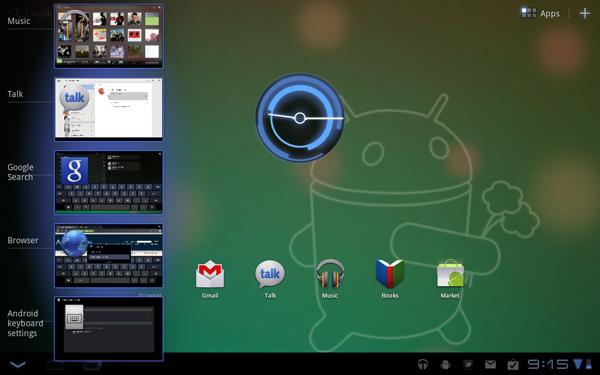
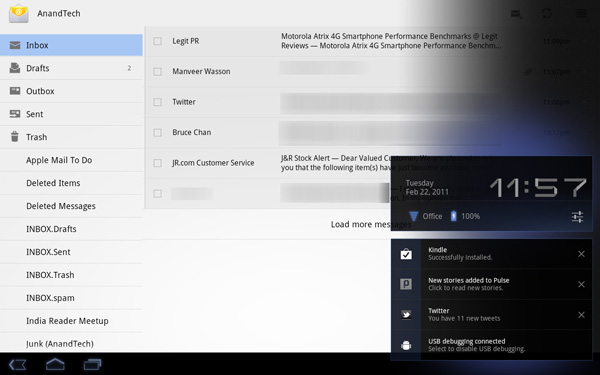
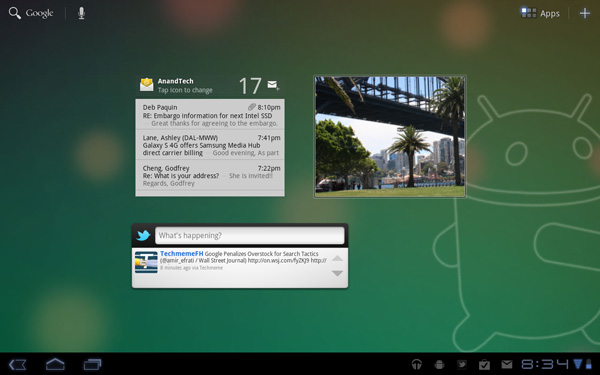
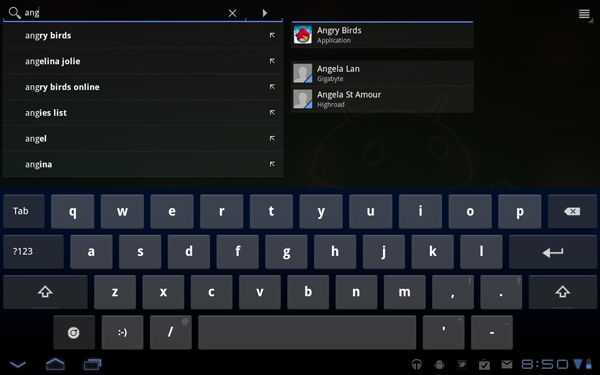
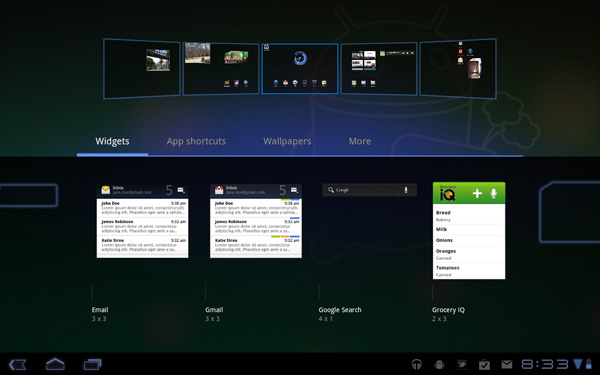
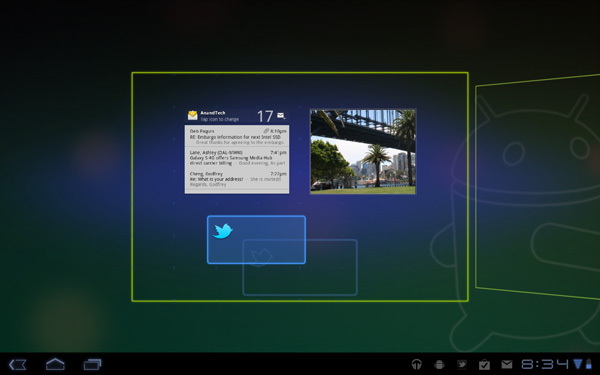
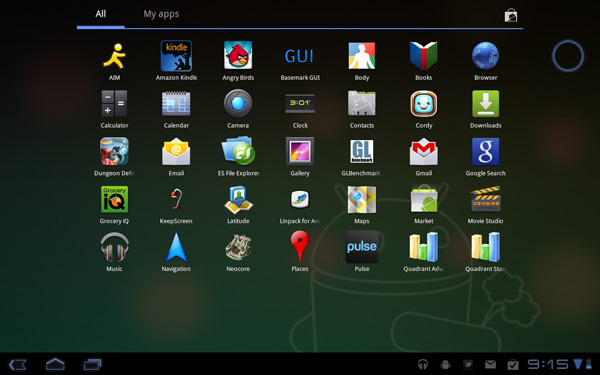
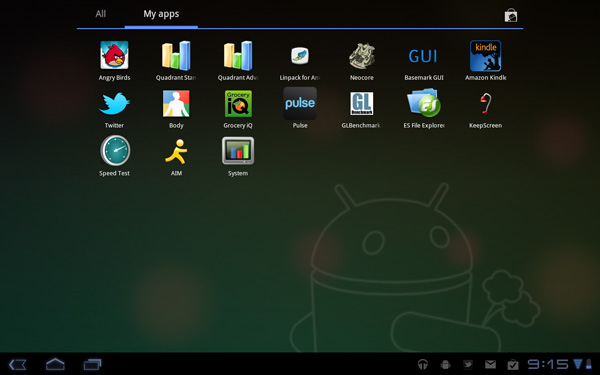








112 Comments
View All Comments
GotThumbs - Friday, March 18, 2011 - link
The platform is not that old. Apple just took their existing ois from the itouch and made it bigger. This is a whole new ballgame. Early adopters should understand their will be some hiccups...Glad to hear the WIFI only version is coming out March 27th for 599.00 This brings the competition directly to ipad and ipad2. My boss offered to buy me the ipad2 and I told him I only want an ADAM or a Xoom. An ipad would be a waste of money....I need a business tablet. Not one whose product is so proprietary...that you can't even load an app unless its through their store....how controlling is that?
Thermogenic - Thursday, February 24, 2011 - link
Samsung changed some of the basic internals of the system (I believe mainly to do with the filesystem and location of certain files). This makes it harder on them to release updates and also causes compatibility problems with certain applications.For me, I would only stick to the high end HTC and Motorola phones - they have the proven track record of updates. If you really want the latest and greatest for some reason, then you will want the Nexus line of phones.
ph00ny - Monday, March 7, 2011 - link
Not entirely true. Most custom froyo roms were based on galaxy s from overseas. Look at captivate, AT&T's froyo update just came out and the same phone offered through canadian carrier had froyo for quite some time nowchocks - Thursday, February 24, 2011 - link
"Android however did it the simplest way possible: tap home and run what you want to run next." Pre-Honeycomb Android has press-and-hold on the Home button which brings up a list of recently-used apps and can be used to switch between running tasks. Has had this since the first release I think.Anand Lal Shimpi - Thursday, February 24, 2011 - link
Woops, you're right :) That's very much a precursor to what Google did in Honeycomb, and tap-and-hold home is now out.Updated!
Take care,
Anand
Thermogenic - Thursday, February 24, 2011 - link
It's not a true tablet, but the NOOKcolor is a nice device for the money. If you are willing to do a little dirty work (mainly writing to a microsd card and booting it - very easy), you get a very basic tablet with a very nice screen for $250.I imagine for most users who use their tablet for web browsing, facebook, twitter, and youtube, that's plenty and a great bargain.
I guarantee there will be a usable version of Honeycomb running on it within six weeks. There is already a functional version, although with a decided lack of applications and very unoptimized.
wumpus - Monday, February 28, 2011 - link
I can't imagine anyone else competing with a wifi only tablet. My guess is that there are two reasons to avoid releasing such: First, you can overcharge and let the consumer pay the subsidy (and then some) back to the carrier. Second: nobody tries to compare it to the nook.Enormously Hatworthy - Thursday, February 24, 2011 - link
I read so many of those tech blogs that sometimes I forget what a real review looks like. Good work.Some of those benchmark results are pretty odd.
I wonder if the disparity between the Optimus 2X and the Xoom might in some way be related to the dual-core support in Honeycomb? The optimus is running on 2.2 which I understand has limited (if any) support for multiple cores.
Maybe the benchmark apps are showing some measure of incompatibility with the new code? Just a wild guess.
cj100570 - Thursday, February 24, 2011 - link
Just once I'd like to read a review of any piece of mobile tech where the reviewer stuck to reviewing the hardware in his/her hands instead of constantly comparing it to an Apple product. For Christs sake, enough is enough already! And don't give me that "Apple Set The Bar" BS. I'm not buying what you're selling! I've owned 3 generations of iPhones, an iMac, and 2 MacBooks so I'm very familiar with Apple products and I have great respect for them. But the simple fact of the matter is that not everyone wants to live the iOS/OS X lifestyle and when they read a review of non Apple products I'm quite sure they don't want to see Apple brought up every other sentence.Enormously Hatworthy - Thursday, February 24, 2011 - link
It is annoying but whether we like iOS/iPad or not (and I don't, to be honest) it is the market leader in tablets right now. It's the frame of reference for buyers.I think they'd be doing their readers a disservice if they didn't make the comparison.
Notice that in laptop/desktop reviews you'll see scarcely a mention of Apple products (unless they're talking about size and weight).